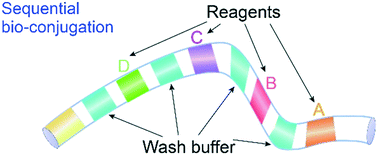A sequentially bioconjugated optofluidic laser for wash-out-free and rapid biomolecular detection†
Abstract
Microstructures can improve both sensitivity and assay time in heterogeneous assays (such as ELISA) for biochemical analysis; however, it remains a challenge to perform the essential wash process in those microstructure-based heterogeneous assays. Here, we propose a sequential bioconjugation protocol to solve this problem and demonstrate a new type of fiber optofluidic laser for biosensing. Except for acting as an optical microresonator and a microstructured substrate, the miniaturized hollow optical fiber (HOF) is used as a microfluidic channel for storing and transferring reagents thanks to its capability in length extension. Through the capillary action, different reagents were sequentially withdrawn into the fiber for specific binding and washing purposes. By using the sequentially bioconjugated FOFL, avidin molecules are detected based on competitive binding with a limit of detection of 9.5 pM, ranging from 10 pM to 100 nM. It is demonstrated that a short incubation time of 10 min is good enough to allow the biomolecules to conjugate on the inner surface of the HOF. Owing to its miniaturized size, only 589 nL of liquid is required for incubation, which reduces the sample consumption and cost for each test. This work provides a tool to exploit the potential of microstructured optical fibers in high-performance biosensing.



 Please wait while we load your content...
Please wait while we load your content...